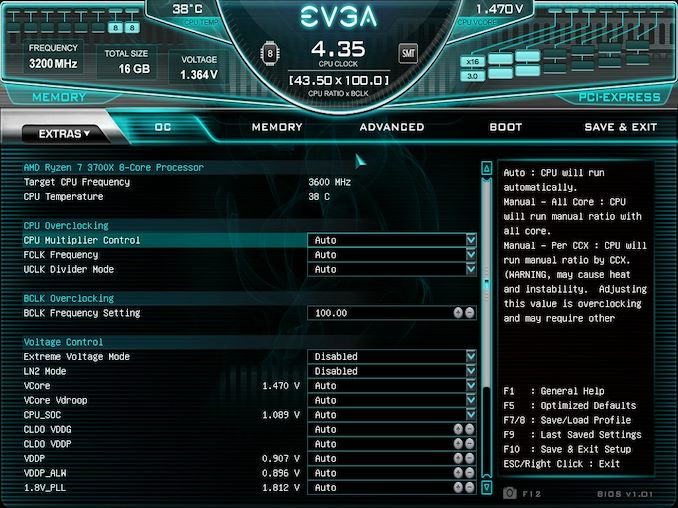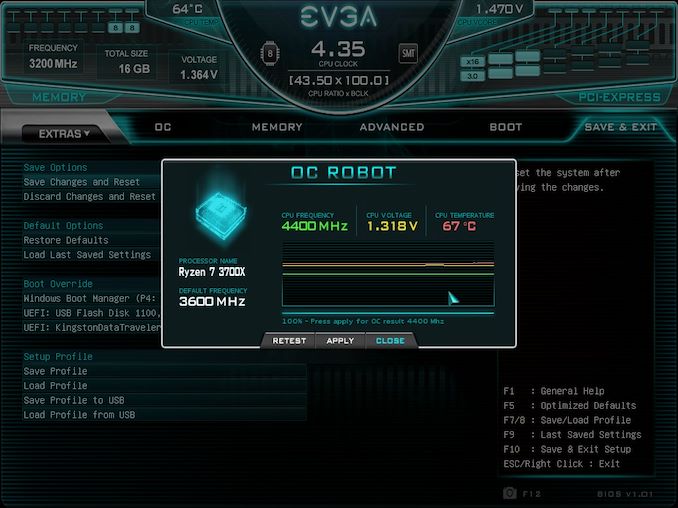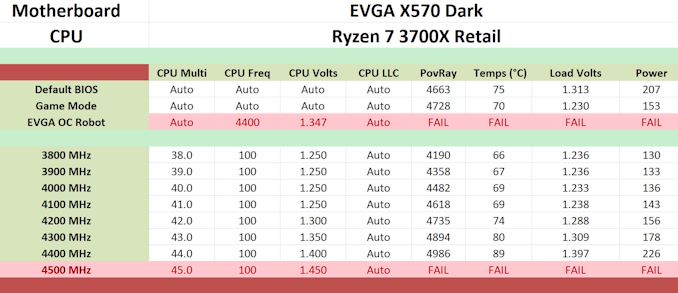The EVGA X570 Dark Motherboard Review: A Dark Beast For Ryzen
by Gavin Bonshor on October 8, 2021 8:00 AM ESTOverclocking Ryzen 3000
Experience with the EVGA X570 Dark
Despite AMD's Ryzen 5000's presence on the current market and support for these across various AM4 chipsets, we do all of our AM4 testing with the Ryzen 7 3700X processor for consistency. Overclocking can yield many benefits in performance, but at the drawback of extra heat and power. This is a consequence of adding more CPU VCore. (It should also be noted that right now I do not have a 5950X for motherboard testing, but as we've used this 3700X for so many AM4 boards in the past, we know its characteristics quite well - an overclocking motherboard should also be able to push other CPUs than just the flagships too).
Most power delivery is over-engineered to support the latest processors, however hot they run. This is a continuance of CPU vendors constantly pushing default and turbo clocks, pushing the silicon to its limits. Anyone looking to overclock will need to consider more aggressive cooling types such as hefty premium AIOs.
Focusing on the EVGA X570 Dark, it's full of options for users to overclock both the CPU and memory. Designed primarily for extreme overclocking, it has an LN2 mode which users can enable in the firmware. To overclock the processor, users can adjust the CPU multiplier, which controls the frequency in 0.25 increments. This is great for fine-tuning extra amounts of frequency where regular x100 MHz increments yield instability. There are also many voltage options for users to tweak, but general users should leave these on automatic as most of them relate to extreme overclocking. Users can push the voltage limits beyond the norm with the Extreme Voltage Mode option.
The memory section is also full of options for users to customize, with options including frequency, voltages, and latencies. Users can enable X.M.P 2.0 memory profiles on compatible memory kits, although EVGA does include some custom memory profiles for high bin memory, which Vince has tuned.
One of the more interesting overclocking options comes via the EVGA OC Robot. The OC Robot function allows users not confident in overclocking to let the firmware do the work. This includes stress testing at each frequency, which is likely done via a built-in lookup table based on specific parameters such as voltages. This kind of feature isn't new, but it's one for users looking to get a good baseline on what their processor is capable of without doing copious amounts of tweaking and stress testing.
Overclocking Methodology
Our standard overclocking methodology is as follows. We select the automatic overclock options and test for stability with POV-Ray and OCCT to simulate high-end workloads. These stability tests aim to catch any immediate causes for memory or CPU errors.
For manual overclocks, based on the information gathered from the previous testing, start off at a nominal voltage and CPU multiplier. The multiplier is increased until the stability tests are failed. The CPU voltage is increased gradually until the stability tests are passed. The process is repeated until the motherboard reduces the multiplier automatically (due to safety protocol) or the CPU temperature reaches a stupidly high level (105ºC+). Our testbed is not in a case, which should push overclocks higher with fresher (cooler) air.
We overclock with the Ryzen 7 3700X for consistency with our previous overclocking tests.
Overclocking Results
Overclocking is supposed to be EVGA's bread and butter with the Dark series, and our testing with the X570 Dark shows this to be very fruitful. There are two overclocking presets of sorts to select from, the Game Mode and the EVGA OC Robot. Testing both of them compared with the default settings, the Game Mode performed around what we would expect with an all-core overclock of 4.1 to 4.2 GHz level, but with lower CPU VCore and, ultimately, lower temperatures and power draw.
The EVGA OC Robot done its magic, and we ended up with a 4.4 GHz all-core overclock at 1.318 V. Knowing previously what our limits were with our chip, we did feel this was going to be too conservative to run with POV-Ray, and it was, as the overclock itself failed to complete the test. As we tested each 100 MHz increase, POV-Ray performance consistently went up as a result.
Interestingly, we managed to get an all-core overclock of 4.4 GHz at 1.400 V, which is the furthest we have managed on this chip. It's clear the EVGA X570 Dark has the edge over the more conventional X570 motherboards, but it showed its true colors and prowess in engineering to achieve this.













36 Comments
View All Comments
Eliadbu - Saturday, October 9, 2021 - link
Or RGB, but it has 2nd NIC and m.2 key E (incase you want to add wifi card).jtd871 - Friday, October 8, 2021 - link
AFAIK, RAM overclocking is more stable when you are using only 2 sticks, and this is a 'halo' board designed primarily for competitive overclocking.You wouldn't use a top-fuel dragster as your daily commuter car or to show up to a formal red-carpet event. In the same way, this board is not intended for 'normal' computing or gaming.
Threska - Friday, October 8, 2021 - link
Now I'm just waiting for the workstation/server version.WaltC - Friday, October 8, 2021 - link
I couldn't believe that I read this sentence in the review of this mboard:"While these comments make sense, ultimately very few users apply memory profiles (either XMP or other) as they require interaction with the BIOS."
There will be zero (0) customers of this motherboard who will decline to use the bios...;) Every single one of them will be quite conversant with the bios and eager to use it.
Seem to be a lot of this kind of general assumptions here that really have no relevance for the people who will be buying this product.
WaltC - Friday, October 8, 2021 - link
If I missed the place where you discussed a dual bios on this motherboard, or its lack of one, I beg pardon. But there are a lot of interesting DIP switches visible on this motherboard and a brief explanation would have been nice. Also, why would you test a 65W CPU with this board? Seems like a 5900X or 5950X would have been far more interesting, not to mention in keeping with the type of CPU a customer of the $690, OC'ing board is much more likely to purchase.I did agree with your conclusion, though, about boards costing half as much having very similar features and options--for instance, my two-year old x570 Aorus Master ($350) includes both the RT 1220-VB HD & a headphone AMP for onboard sound, but the x570 Master also includes a hardware DAC, the SABRE 9118, while the EVGA board lacks a hardware DAC. The Master includes 4 DIMM slots, and a manually switched dual-bios setup--which in my estimation is just about a requirement for an overclocking board--which the Master is, even though it doesn't have the VRM chops of this EVGA board. But my Master was shipped on the same day that Zen2 CPUs shipped from AMD, so I think the EVGA board is targeting upper-end Zen3 CPUs for OC'ing.
But as I mentioned earlier, trust me when I say that nobody will be buying a $690 OC'ing board who is afraid to go into his bios...;) Glad to see EVGA supporting AMD again, and like you, it will be nice to see a range of AMD4/5 EVGA board products at some point.
Oxford Guy - Saturday, October 9, 2021 - link
"While these comments make sense, ultimately very few users apply memory profiles (either XMP or other) as they require interaction with the BIOS."Stuff like this is a gift (of hilarity) that keeps on giving.
Silver5urfer - Friday, October 8, 2021 - link
There are few things, first this board doesn't use ASM SATA controller, I think you should correct that. All 8 SATA ports are from chipset only. The extra PCB for LN2 also shows the same, Manual also states the same.Now moving on to the board vs Z590 DARK. They removed one NVMe M.2 slot on this, Downgraded the phases and smaller Aluminum heatsink instead of massive Copper block on Interl board, then we have the rear DP and HDMI removed.
Next, the bigger things. First is the USB ports, the board has rear I/O from Chipset only. None of them are from CPU. Usually all X570(S) boards have ton of CPU USB ports, EVGA chose not to for this board. I can guess the only reason being AMD Ryzen 5000 CPUs have issues with the USB ports dropping and all sort of bugs, still not ironed out. So they avoided those, but the front I/O panel ports will be from CPU only, on top they dropped the ASMedia controller for USB C unlike the Z590 DARK. They also dropped the U.2 port.
Next is why they did they go with the Dual DIMM slots, Ryzen doesn't do well with Dual Rank B-Die kits unlike Intel which likes them. Now we have to be too cautious on that part due to the Zen 3 IMC. Now the price, it's highway robbery period. The board is exactly priced at X570 Aorus Xtreme at $700 which not only packs everything this has but even more. Plus it also has the 10G LAN, on top of the HiFi DAC which is not that buggy trash ALC4080 class, instead ALC1200 like this. Crosshair VIII Extreme is $100 more but it has more features, however it has that dreaded garbage ALC4082 and all that ASUS bloatware for the proper functioning of the DAC/AMP hardware. These guys should have included a 10G LAN port at-least, they really are saving a ton of cash on this board, simply a Z590 DARK based PCB design with extra PCIe 4.0 M.2 drive and much more reduced components and choices vs Intel board.
Coming to review, surprised on the DPC latency of this board. Now I'm just waiting on how this board does, esp related to the AMD Ryzen stability with Memory and OC AND USB. Also it's a shame that there's no Ryzen 5000 used for review and no Memory tuning as well. Everything this board got going is all about OC and unlocking potential...
leexgx - Friday, October 8, 2021 - link
If you use 2x dual rank sticks (anything above 16gb per stick) is exactly the same as using 4x8gb single rank sticks (because it's in dual rank due to 2 single ranks per channel)The point of this motherboard is for lm2 overclocking is why there is 2 slots
Slash3 - Saturday, October 9, 2021 - link
EVGA's specifications page does still list two ASMedia SATA ports, and they were incorporated on the Z590 and other, previous Dark boards for XP compatibility. It's possible that they were on internal or pre-release samples but then removed for the retail version.PsychoOC - Friday, October 8, 2021 - link
Whats ironic is the world record holder for most ln2 benchmarks on 3700x is on b450 tomahawk;)